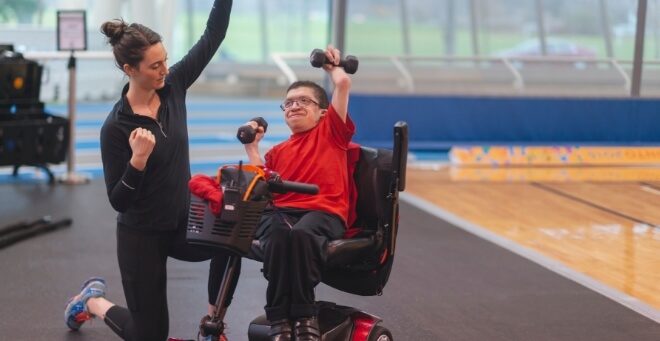The need to consider the special needs of people with intellectual disabilities (ID) in every life situation is rising in a world that has finally begun to value inclusion and diversity. Fitness for intellectual disabilities is one of the areas that have been largely ignored, but it is highly influential.
Although exercise has many health benefits for everyone, it can be life-changing to individuals with intellectual disabilities-not only physically but also emotionally, socially, and with self-concept.
This article investigates the possibility of adapting fitness programs to suit the needs of people with ID, and how such a program can result in the creation of more inclusive communities.
Understanding Intellectual Disabilities and Fitness Needs
Intellectual disabilities are defined by substantial restraint in intellectual performance and adaptive behavior regarding conceptual, societal, and practical abilities. Individuals with ID can have problems with communication, problem-solving, and abstract concepts. These difficulties may affect their participation in mainstream fitness programs unless appropriately modified.
People with ID also have an increased chance of having health problems, such as obesity, cardiovascular disease, and type 2 diabetes. The contributing factors to this disparity are a sedentary lifestyle, an unhealthful diet, and a lack of access to preventive health services. Hence, it is paramount to establish adaptive fitness programs that will manage these health risk factors and be mindful of cognitive and behavioral needs.

Why Fitness Matters for Individuals with Intellectual Disabilities
- Physical Health Advantage
Individuals with intellectual disabilities have an increased risk of multiple health complications, like obesity, cardiovascular disease, diabetes, and poor motor functioning. Healthy exercise may:
- Enhance cardiovascular conditioning and body strength
- Increase flexibility, balance, and coordination
- Promote weight loss and avoid obesity diseases
- Enhance the density of bones and prevent osteoporosis
- Mental and Emotional Health
Exercise for special needs individuals has been known to release endorphins, which eliminates stress and elevates mood. Fitness exercises and activities may help people with ID decrease their levels of anxiety and depressive symptoms, sleep better, and feel generally happier.
- Social Inclusion and Interaction
Group fitness programs are also promising avenues to interact with others. It enhances a sense of belonging, friendship, communication, and teamwork skills, thereby curbing the social isolation many people with ID tend to face.
- Independence and Skill Development
Planned physical exercises are practical for training motor skills, coordination, and such cognitive skills as following instructions and pattern recognition. You will have increased independence in daily life for these gains, which boosts self-esteem and independence.
Designing Inclusive Fitness Programs
It is essential to build programs that are accessible, flexible, and supportive to meet the fitness requirements of people with intellectual disabilities. Some of the best practices of inclusive fitness for disabilities are as follows:
- Educate Employees on Inclusion
The intellectual disability picture should be provided to the fitness professional so that they can know how to modify exercises. These involve clear communication, providing visual aids or demonstrations, patience as well as encouragement.
- Simplify Instructions
Give concise, direct oral instructions. Divide activities into small steps and give instant and positive feedback. Gestures, visual hints, or teaching by demonstration can be more effective than verbal-only teaching.
- Employ Habit and Organization
A good number of people with ID are creatures of habit. The exact structure of classes (warm-up, main activity, and cool-down) allows the participants to understand what will happen during the classes and decrease anxiety.
- Develop Adaptive Activities
Adapt old exercises to suit diverse physical and mental capabilities. Play with softer or bigger balls, help with balancing, and make a game simpler. These are a few ways to make participation easier and more enjoyable.
- Create a Positive Climate
An accepting, non-judgmental, all-inclusive space will foster long-term involvement. Programs that encourage teamwork, recognize and celebrate accomplishments, and accept people of all skill levels help to create this good experience.
- Collaborate with Families and Caregivers
It may be possible to promote and encourage exercise activities after the official sessions are over by involving families and caregivers. They are also able to help in giving details regarding the needs and preferences of participants.
Examples of Inclusive Fitness Initiatives
- Unified Sports and Special Olympics
The Unified Sports and Special Olympics is a sports movement organization that offers regular sports training and competitions to people with ID throughout the year. Unified Sports creates a team of individuals with and without intellectual disabilities and encourages social inclusion and mutual success.
- Local Gyms Adaptive Fitness Programs
Adaptive fitness programs include yoga, Zumba, or circuit training that is offered in many community centers and gyms and is tailored to the needs of people with disabilities. These programs are focused on enjoyment, security, and progressing slowly.
- Therapeutic Recreation Programs (TRPs)
Recreation therapists incorporate exercise in treatment plans for intellectually and developmentally disabled people. These programs integrate physical activity for intellectual disability with life skills training and arts and wellness education.
- Virtual and Home-Based
Technology has created the possibility of designing online fitness programs to meet the needs of people living with disabilities. Online classes are a valuable option for persons having transportation issues or health problems.

Challenges and Barriers
There are some barriers and challenges on the way to providing the best opportunities for health and fitness for special populations:
- Awareness and Training
Lack of awareness about the needs of individuals with ID, and lack of training to work with this population, excludes several fitness professionals who may provide inappropriate programming.
- Transportation and Accessibility Barriers
The problem with accessing fitness centers or recreational facilities is that they may be inaccessible or surrounded by barriers to mobility.
- Social Stigma
Social negative attitudes and poor expectations may deter the participation of people with ID in fitness activities.
- Funding and Resources
Several programs face the challenges of inadequate funding, which hinders the provision of enough quality adaptive fitness services.
Action Plans
- Professional Education
Healthcare professionals, fitness instructors, and physical educators must all receive disability awareness training. It develops empathy, competence, and capacity to develop adaptive programs.
- Partnerships Community Engagement
Partnerships between disability organizations, fitness centers, schools, and healthcare providers can help to provide more access to inclusive programs. Campaigns for community awareness can help combat stereotypes and promote inclusion.
- Policy and Advocacy
Inclusive fitness programs can be established and sustained with the help of institutions and the government through grants, policies, and incentives. Advocates can promote policies that value health equity to persons with disabilities.
- Family/Caregiver Involvement
Families and caregivers have a crucial role in encouraging involvement in exercise regimens.
Conclusion
Helping intellectually disabled people with fitness is not a question of physical well-being only; it is a way to dignity, belonging, and power. Society can demonstrate the full potential of people with ID by ensuring that they understand their specific needs and advantages and provide comprehensive, welcoming, and interesting conditions.
Inclusive and accessible workout programs are not only valuable for individuals with intellectual disabilities- they add value to the whole community, enhancing understanding, inclusion, and mutual development. Movement, understanding, and opportunity are the way forward to a healthier and more inclusive world.












